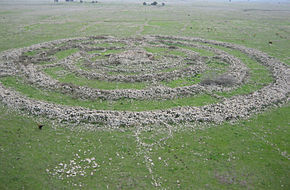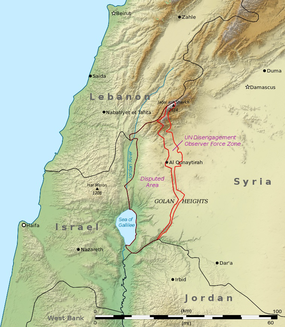Gilgal Refaim
| رُجم الهِرّي גלגל רפאים |
|

Rujm el-Hiri – Gilgal Refaim
|
|
| Alternate name | Rogem Hiri, Galgal Refaim |
|---|---|
| Location | Golan Heights |
| Coordinates | 32°54′31″N 35°48′03″E / 32.908705°N 35.800705°E |
Rujm el-Hiri (Arabic: رجم الهري, Rujm al-Hīrī; Hebrew: גִּלְגַּל רְפָאִים Gilgal Refā'īm or Rogem Hiri) is an ancient megalithic monument, consisting of concentric circles of stone with a tumulus at center. It is located in the Israeli-occupied portion of the Golan Heights, some 16 kilometers east of the coast of the Sea of Galilee, in the middle of a large plateau covered with hundreds of dolmen.
Made up of more than 42,000 basalt rocks arranged in concentric circles, it has a mound 15 feet (4.6 m) tall at its center. Some circles are complete, others incomplete. The outermost wall is 520 feet (160 m) in diameter and 8 feet (2.4 m) high. The establishment of the site, and other nearby ancient settlements, is dated by archaeologists to the Early Bronze Age II period (3000–2700 BCE).
Since excavations have yielded very few material remains, Israeli archeologists theorize that the site was not a defensive position or a residential quarter but most likely a ritual center, possibly linked to the cult of the dead. However, there is no consensus regarding its function, as no similar structure has been found in the Near East.
The name Rujm el-Hiri, "stone heap of the wild cat", appears on Syrian maps. The term rujm in Arabic (pl. rujum; Hebrew: rogem) can also refer to a tumulus, a heap of stones underneath which human burial space was located. The name is sometimes romanized as Rujm Hiri or Rujum al-Hiri.
...
Wikipedia

